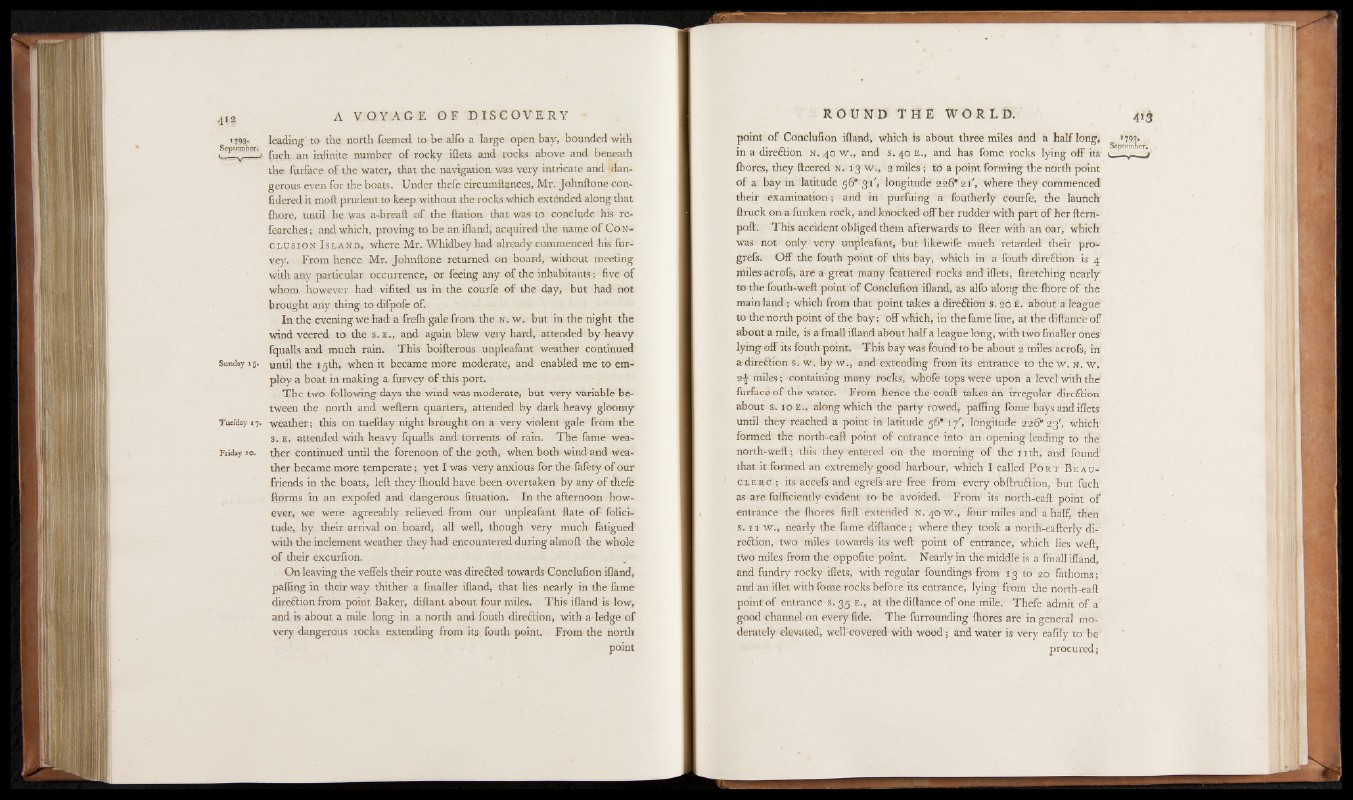
1793- leading to the north feemed to be alfa a large open bay, bounded with
September^ an ;ng njte number of rocky illets and rocks above and beneath
the furface of the water, that the navigation was very intricate and dangerous
even for the boats. Under thefe circumftances, Mr. Johnftone considered
it moll prudent to keep without the rocks which extended along that
fhore, until he was a-breaft of the flation that was to conclude his re-
fearches; and which, proving to be an illand, acquired the name of CoN-
c lus ion I sland, where. Mr. Whidbey had already commenced his fur-
vey. From hence Mr. Johnftone returned on board, without meeting
with any particular occurrence, or feeing any of the inhabitants; five of
whom however had vifited us in the courfe o f the day, but had not
brought any thing to dilpofe of.
In the evening we had a frefti gale from the n. w . but in the night the
wind veered to the s. e., and again blew very hard, attended by heavy
Iqualls and much rain. This boifterous unpleafant weather continued
Sunday 15. until the 15th, when it became more moderate, and enabled me to employ
a boat in making a furvey o f this port.
The two following days, the wind was moderate, but very variable between
the north and weftern quarters, attended by dark heavy gloomy
Tuefday 17. weather; this on tuefday night brought on a very violent gale from the
s. E. attended with heavy fqualls and' torrents o f rain. The fame wea-
Friday so. ther continued until the forenoon of the 20th, when both wind and weather
became more temperate; yet I was very anxious for the fafety of our
friends in the boats, left they fhould have been overtaken by any o f thefe
ftorms in an expofed and dangerous fituation. In the afternoon however,
we were agreeably relieved from our unpleafant ftate o f folici-
tude, by their arrival on board, all well, though very much fatigued
with the inclement weather they had encountered during almoft the whole
o f their excurfion.
On leaving the veffels their route was direfted towards Conclufion illand,
pafling in their way thither a fmaller illand, that lies nearly in the fame
direftion from point Baker, diftant about four miles. This illand is low,
ahd is about a mile long in a north and fouth direftion, with a- ledge of
very dangerous rocks extending from its fouth point. From the north
point
point o f Conclufion illand, which is about three miles and a half long,
in a direftion n. 40 w., and s. 40 e., and has feme rocks lying off its
lb ores, they fleered w. 13 w,, 2 miles ; to a point forming the north point
o f a bay in latitude 56* 31', longitude 226*21', where they commenced
their examination ; and in purfuing a foutherfy courfe, the launch
ftruck on a funken rock, and knocked off her rudder with part o f her ftern-
poft. This accident obliged them afterwards to fteer with an oar, which
was not only very unpleafant, but likewife much retarded their pro*
gfels. Off the fouth point of this bay, which in a fouth direftion is 4
miles acrofs, are a great many feattered rocks and illets, ftretching nearly
to the fouth-weft point of Conclufion illand, as alio along the fliOre of the
main land ; which from that point takes a direftion s. 26 E. about a league
to the north point of the bay; off which, in the fame line, at the diftance of
about a mile, is a fmall illand about half a league long, with two fmaller ones
lying off its fouth point. This bay was found to be about 2 miles acrofs, in
a direftion s. w. by w., and extending from its entrance to the w . n. w .
2 f miles ;J Containing many roeks, whole tops were upon a level with the
furface o f the water. From hence the coaft takes an irregular direftion
about s, t o t , along which the party rowed, palling fome Bays and illets'
until they reached a point in latitude 56* 17', longitude 226* 23*, which
formed the north-eaft point of entrance into an opening leading to the
north-weft; this they entered on the morning of the 11 th, and found'
that it formed an extremely good harbour, which I called Po r t Beau-
Clerc ; its accefs and egrefs-are free from every obftruftion, but fuch
as are fufficiently evident to- be avoided. From its north-eaft point of
entrance the Ihores firft extended N. 4b w . , four miles and ahalf, then
s, 11 w ., nearly the fame diftance; where they took a north-eafterly di-'
reftion, two miles towards its weft point o f entrance, which lies well,
rtvo miles from the oppofite point. Nearly in the middle is a fmall illand,
and fundry rocky illets, with regular foundings from 13 to zo fathoms;'
and an iflet with fome rocks before its entrance, lying from the north-eaft
point of entrance s, 35 E., at the diftance of one mile. Thefe admit of a
good channel on every fide. The furrounding Ihores are in general moderately
elevated, well covered with wood; and water is very eafily to be
procured;